How to Make Ricotta From Whey
This post may contain affiliate links, view our disclosure policy for details.
In this post, we will learn how to make ricotta from whey. After making cheese, we are left with a good amount of whey, making ricotta from it is simple and quick. This homemade ricotta from whey is delicious and very simple to make!
There are many things you can do with the whey that is left after you make cheese at home. Honestly, I usually do one of two things… I either give it to the animals or use it when making bread as a replacement for the water in the recipe. Recently, I found out that before I use it for those things, I can make one more kind of cheese from it — Ricotta.
This recipe is good whether you are using store-bought milk or raw milk, goat milk, or cow’s milk… I am using my raw goat’s milk to make most of my homemade cheeses and in this post, I’ll be using the whey from this milk to show you how to make ricotta from whey.
How to Make Ricotta From Whey…
It takes some serious effort to keep goats (I raise Lamancha goats) alive here in NC. I am not sure if everyone all over the country experiences this but here in NC goats die like flies. We have very hot and very humid summers. The perfect ground for so many parasites. Not only are they abundant, they are also aggressive and very resistant to medications.
Anyway, this is a topic for another post, but what I am trying to say is that when I do get delicious goat milk from my goats, you can bet that I am going to do the best I can to use it to the fullest. Here are some of the ways that I use my goat milk…
- Make goat milk soap
- Make feta cheese
- Make soft, spreadable cheese
- Make hard goat cheese (a recipe that I’ve learned in the mountains of Israel!)
- Make yogurt
- And I also can my milk!
What Kind of Whey Can Be Used…
You can use whey from goat’s milk, cow’s milk, sheep’s milk… However, This ricotta can only be made from whey that was produced from making cheese without acids like vinegar, lemon juice, or citric acid. If you used vinegar to make your cheese, your cheese produced whey, and you are here trying to follow this recipe to make ricotta, this will not work. Take a moment to read some of the comments below… Lots of people tried this, some with success and some not so much. After a few years, that’s the conclusion we came to.
What is Ricotta Cheese…
Ricotta cheese is a creamy, white, mild, and soft texture cheese. Traditionally, Italian cheese makers made ricotta from whey left behind after making Mozzarella or Provolone cheese. Ricotta consists of delicate granules that are moist and is very rich in calcium.
You can use ricotta cheese in pasta, especially filled pasta like lasagna, ravioli, and tortellini. You can season it and add it to salads or sandwiches, and it is so good as a dessert with some honey, fruit, chocolate, or jam.
Tools That We Are Going to Need…
- Stainless pot – it’s best if it’s a heavy bottom pot so the whey doesn’t scorch when we heat it.
- A slotted spoon – or another stainless spoon for stirring the whey.
- A cheese thermometer – or any other kind of thermometer that can read to 200 degrees F.
- 1/4 cup measuring cup – to measure the vinegar.
- A colander – or you can use a strainer or a bowl. We will line it with the cheesecloth before we hang the cloth. If you don’t want to catch the whey then you can use a strainer or a colander and place it in the sink.
- Cheesecloth – let me tell you a secret… You don’t need a fancy cheesecloth! Your local Walmart sells a pack of five or so flour sack tea towels for something around $5. I am linking to a “proper” cheesecloth in case you are not sure what a cheesecloth is. The flour sack towels that I get at my local Walmart work better than a cheesecloth in my opinion and they are so cheap! It’s all you need. Also, make sure to have a string of some sort (I use yarn) to tie and hang the cheesecloth with.
For a comprehensive list of cheesemaking equipment and ingredients, make sure to visit my cheesemaking equipment post. Ok, we are ready to go through this ricotta from whey tutorial. You’ll find all the steps below, however, if you want to have a better understanding of the cheesemaking process, please visit my How to Make Cheese at Home post.
Ingredients…
- Whey
- Vinegar – apple cider or white. In this tutorial, I used my apple scrap vinegar.
- Salt – sea, cheese, or Kosher
Making Ricotta From Whey…
Step one – heat the whey. Add the whey to a heavy-bottomed pot, and set on the stovetop. Turn the heat to medium and slowly heat the whey to 195 degrees Fahrenheit while stirring frequently so it doesn’t scorch.
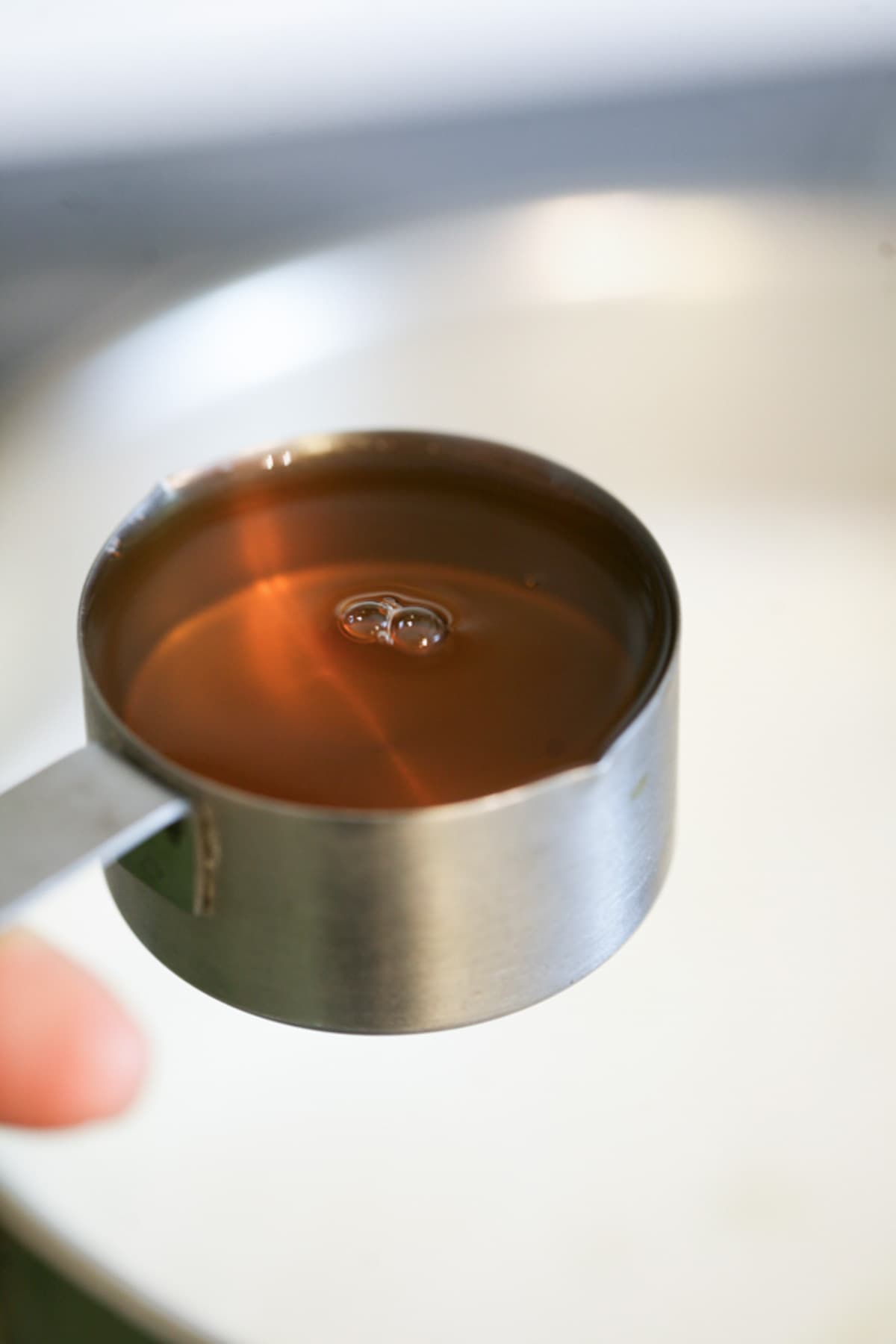

Step two – add the vinegar. Remove the pot from the heat and add the vinegar. Stir it in for a minute or so. You’ll see that the whey starts to curdle. Let it sit for a few minutes.
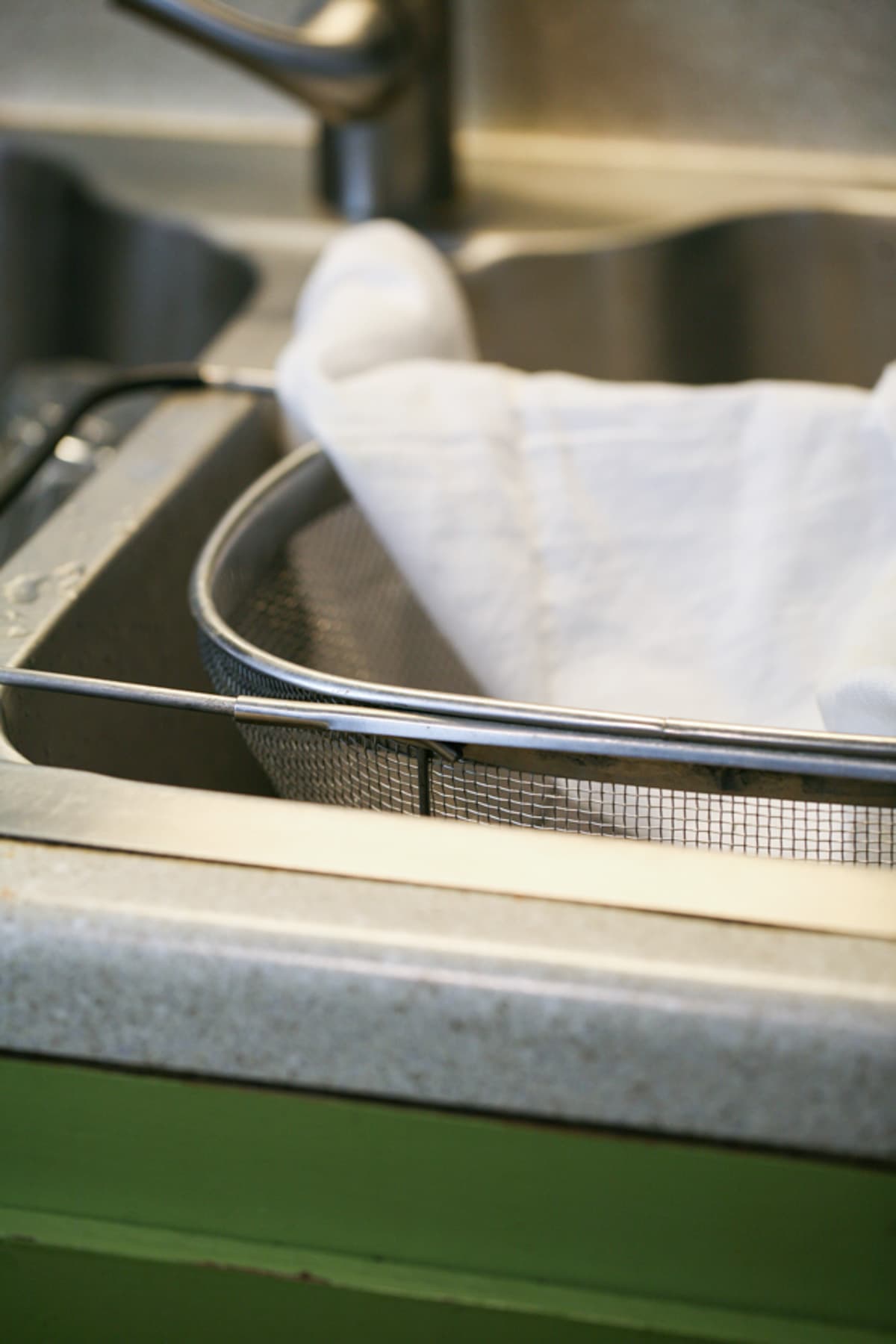
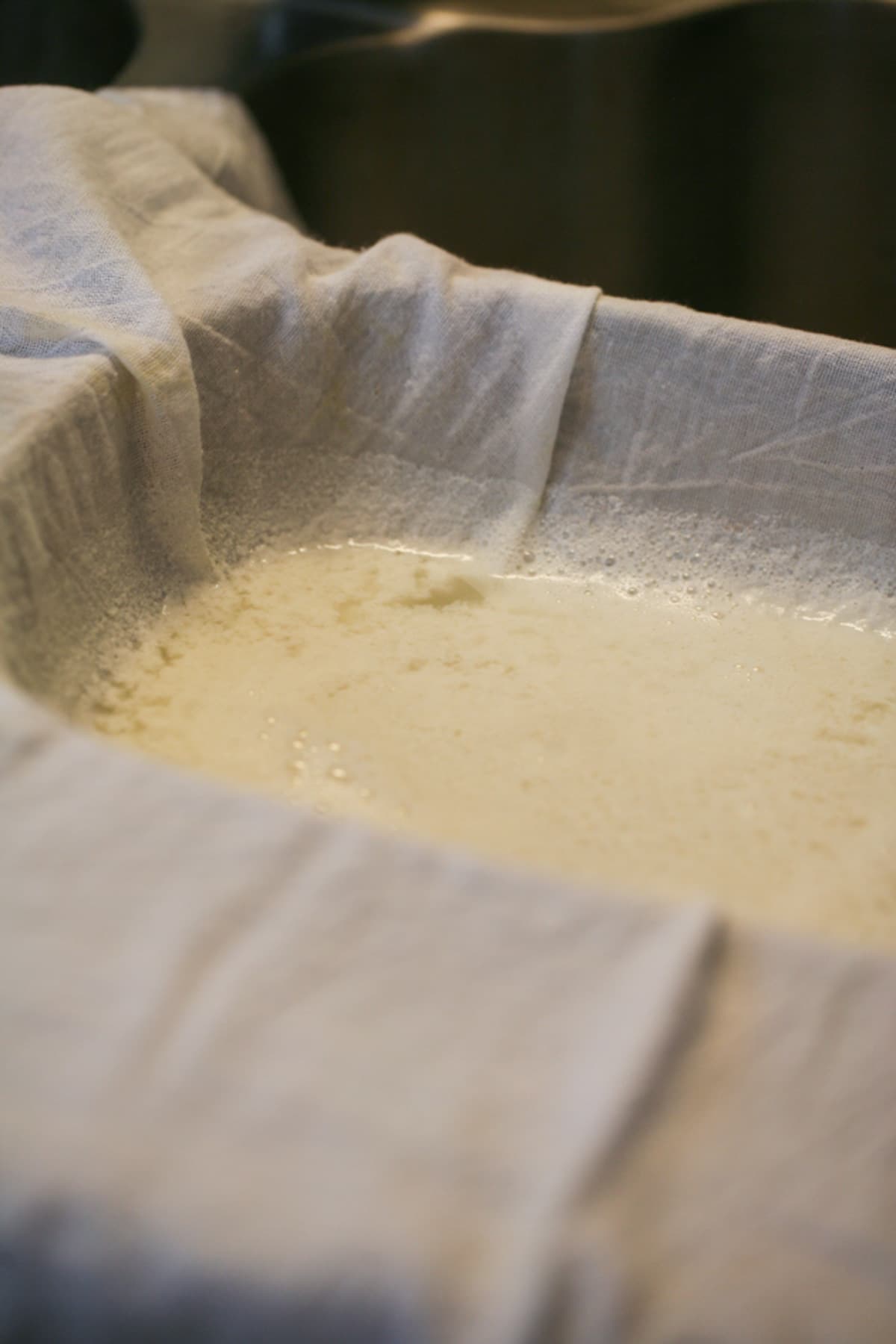
Step three – strain the whey. Place a strainer over the sink or over a bowl if you want to catch the liquid and line it with a cheesecloth or a flour sack towel. Pour the curdled whey onto the flour sack and let the liquid drain for a few minutes.
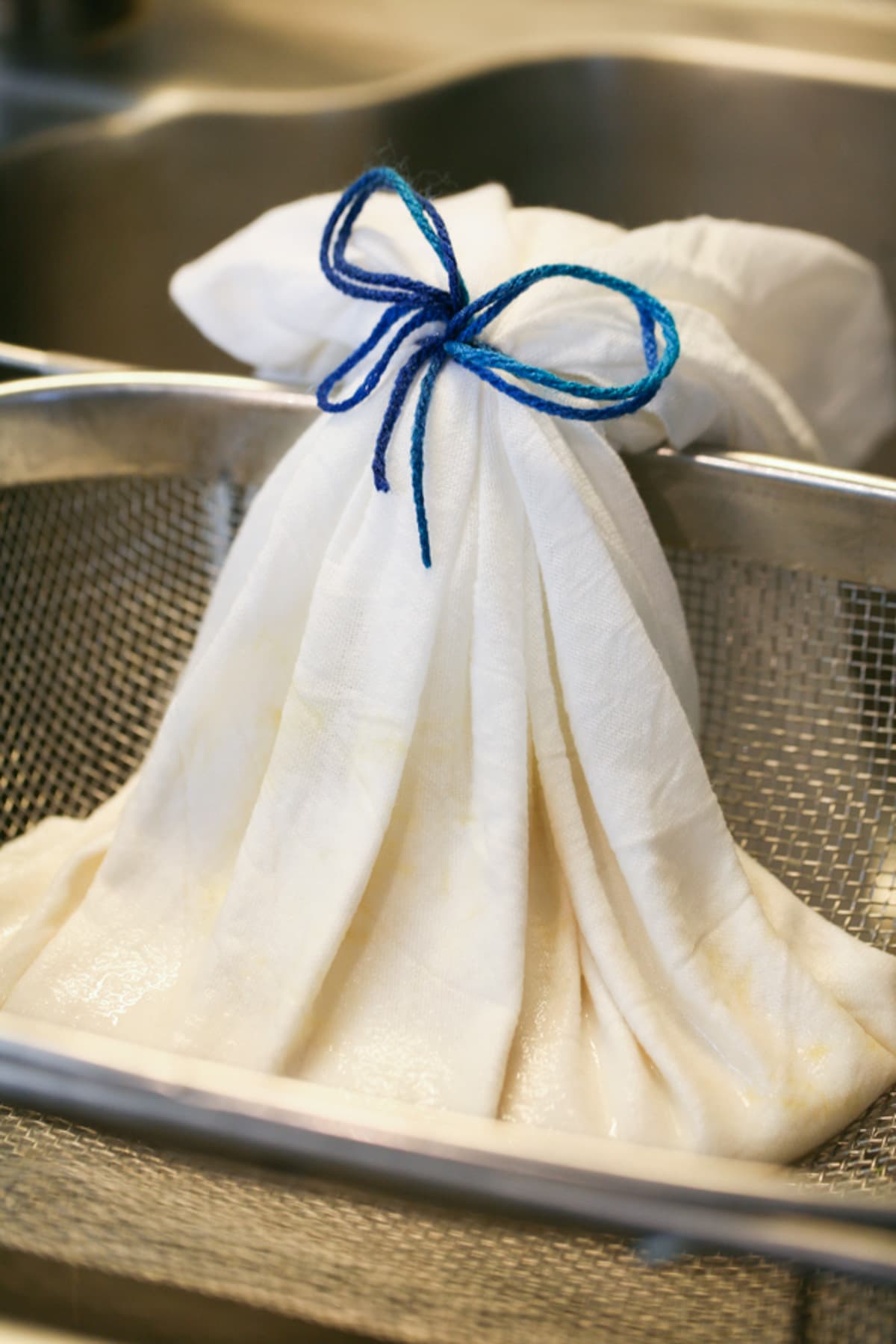
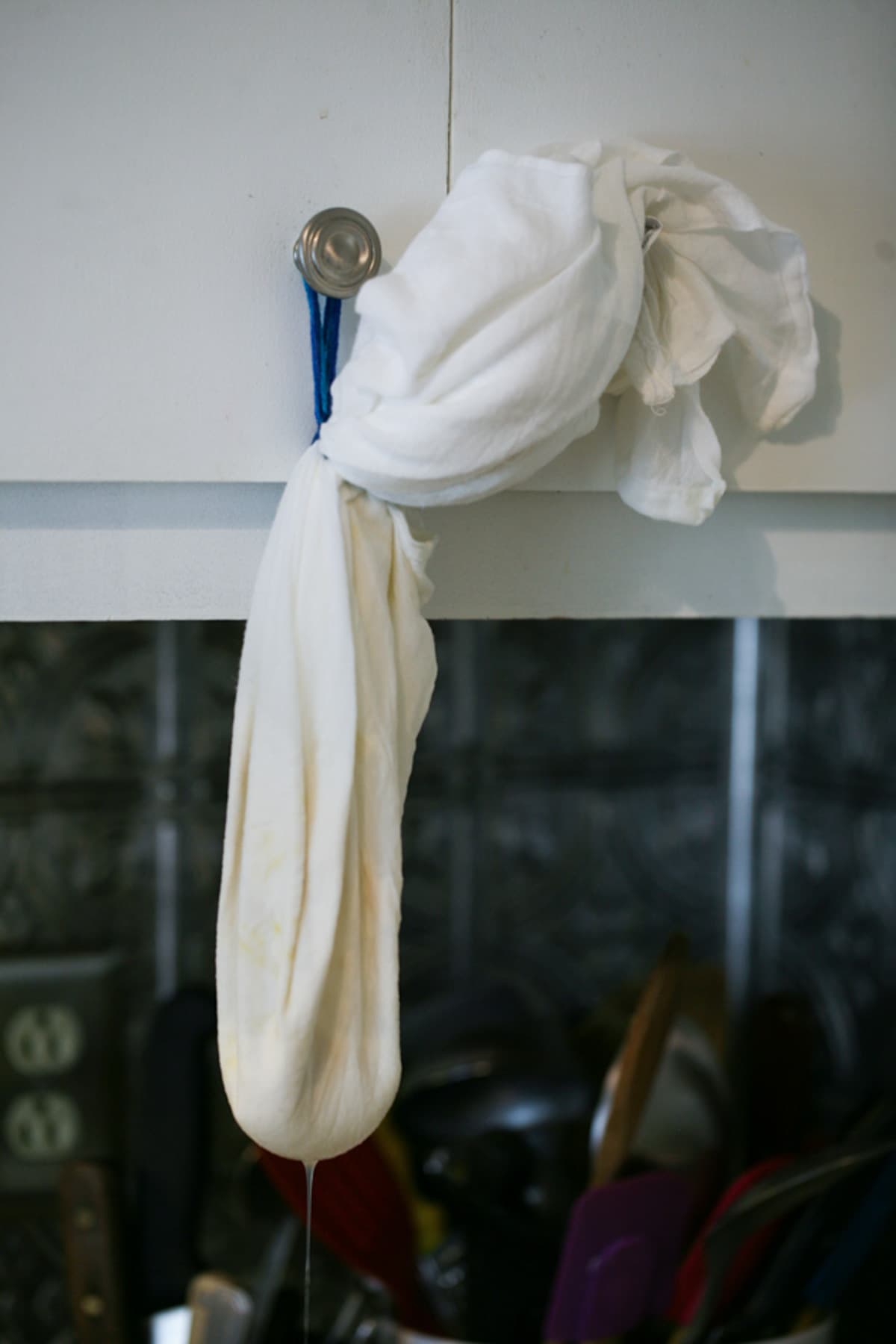
Step four – hang. Gather the ends of the flour sack and tie them. Then hang the flour sack on one of your kitchen cabinets with a bowl underneath it to catch the remaining whey. Depending on the amount of whey you are processing, you might need to leave the bag hanging from one hour to five or six or seven hours.
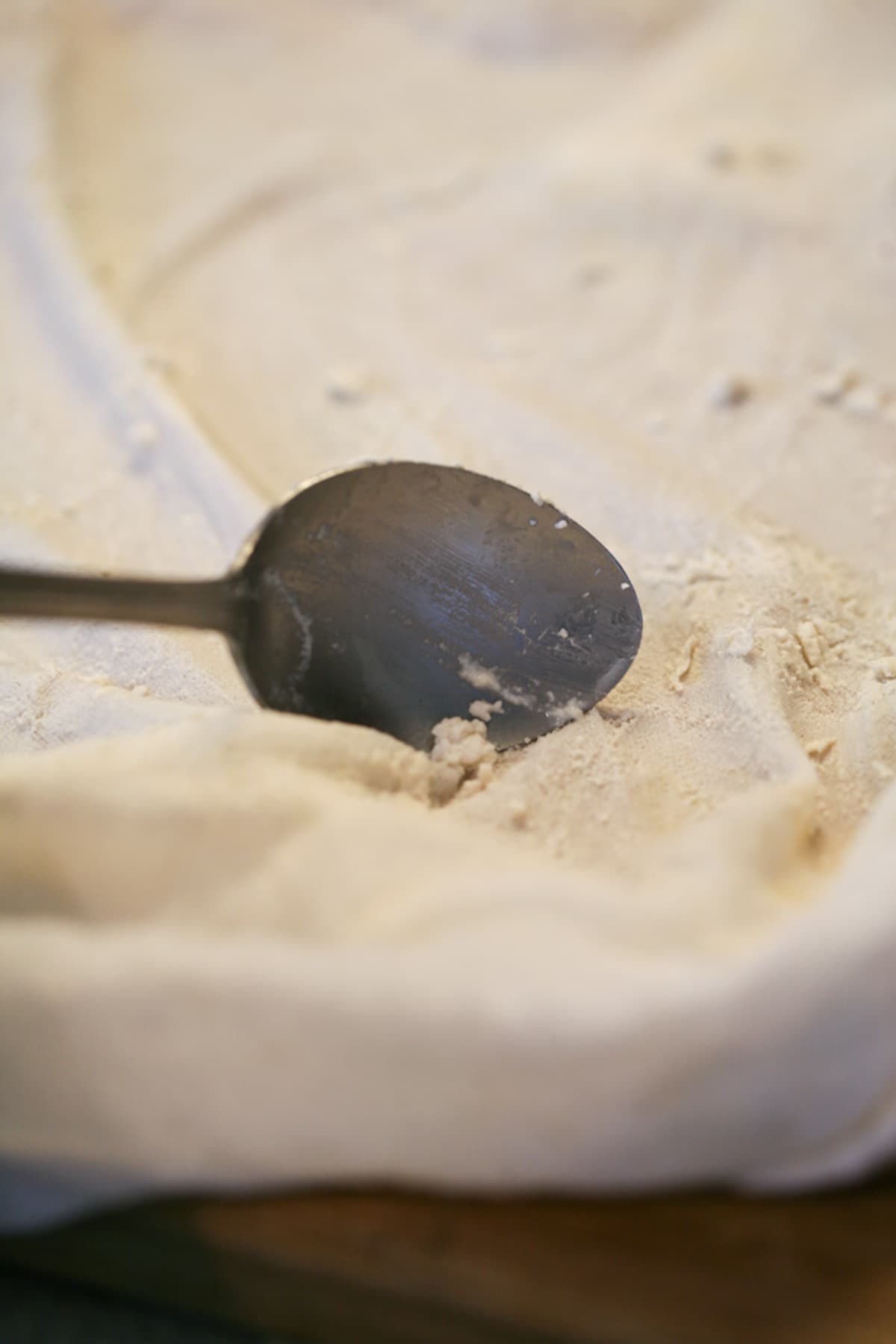
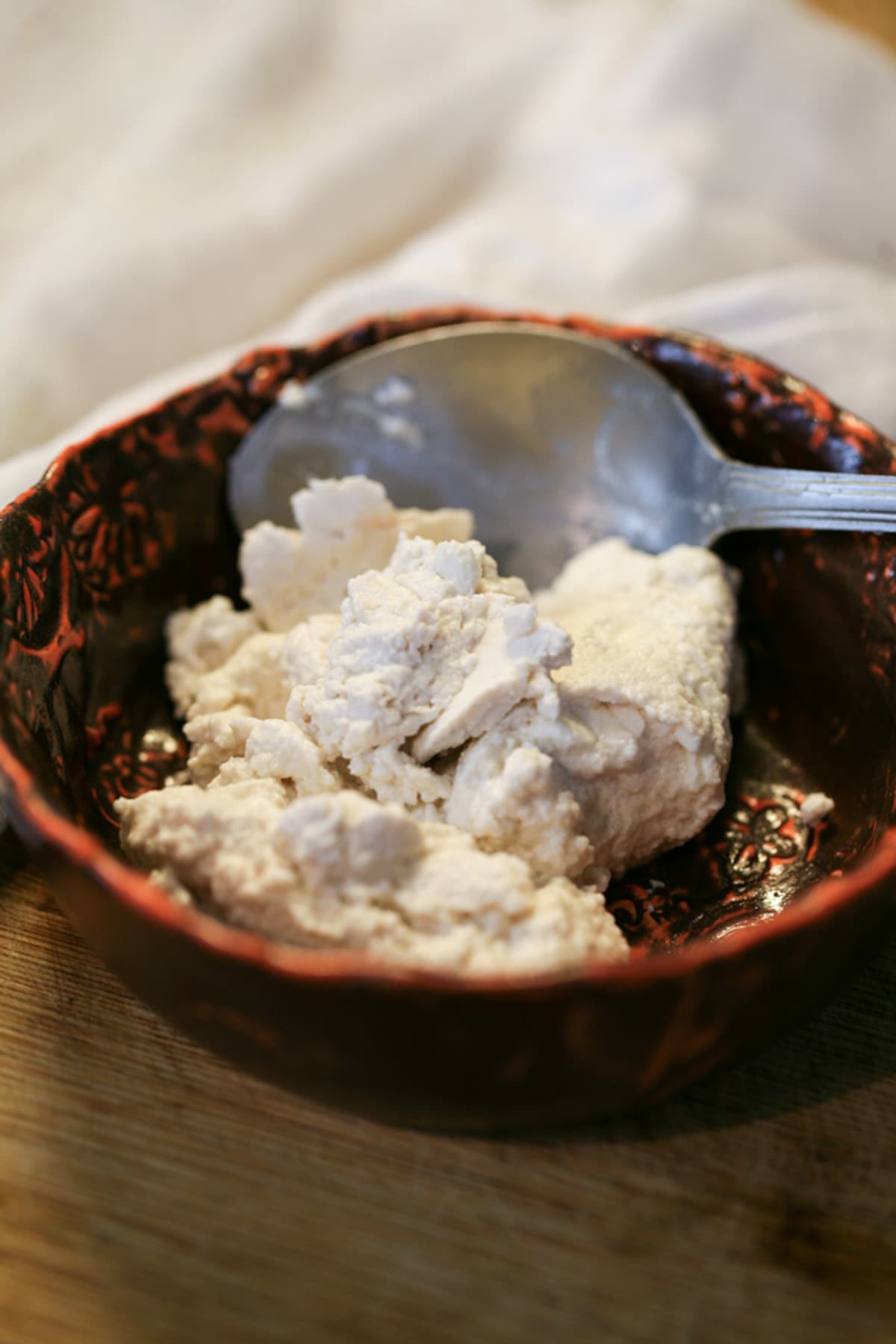
Step five – remove the cheese from the flour sack. Open your flour sack and use a spoon to scrape the soft ricotta into a bowl.
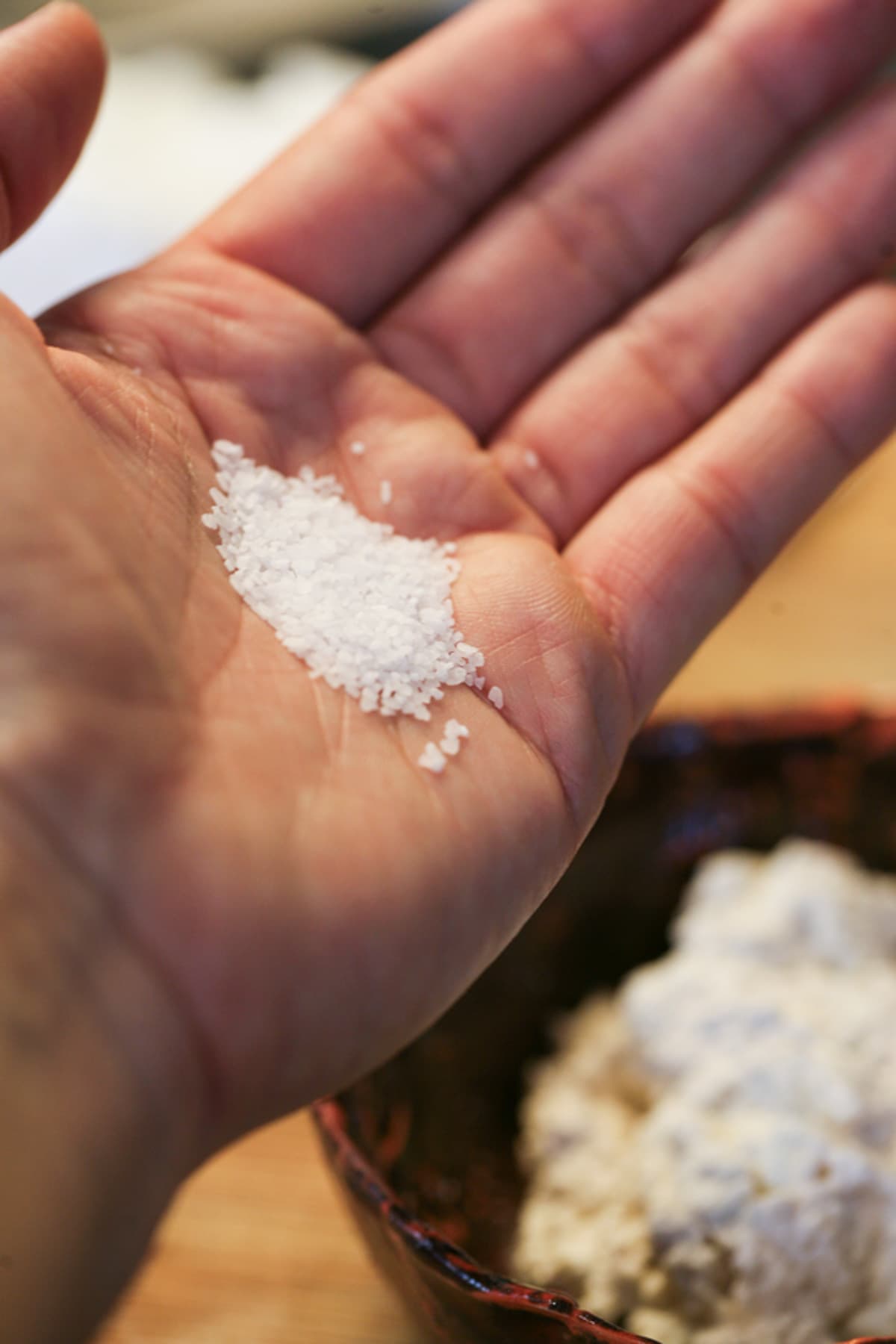
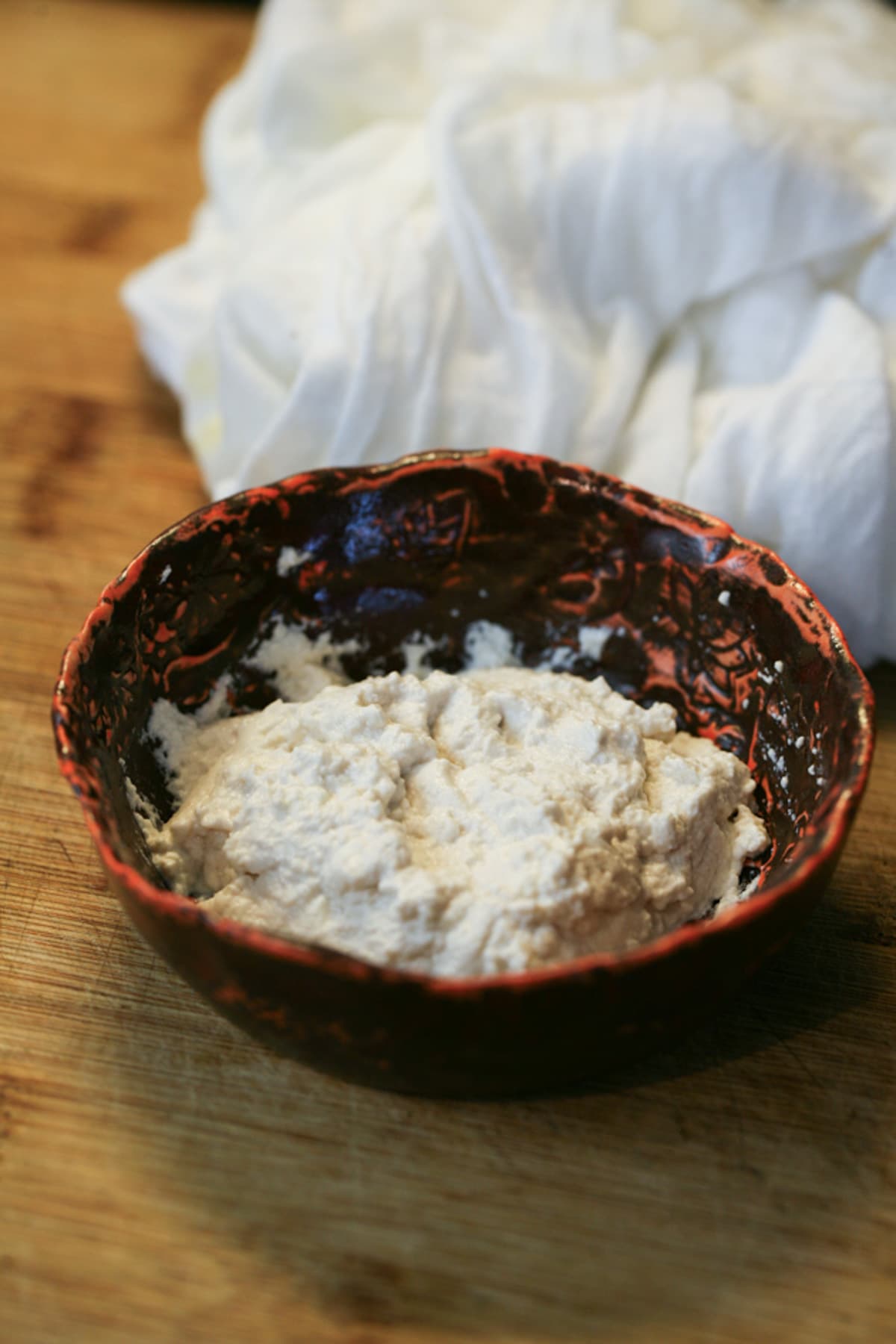
Storing Your Made from Whey Ricotta Cheese…
Before you store your cheese, salt it to your taste. Remember to use non-iodized salt. Sea, Kosher, or cheese salt will do. Mix the salt well into the cheese. Add the cheese to an air-tight container and store it in the fridge.
Serving…
Your made-from-whey ricotta cheese can be served right away, however, like every homemade cheese, it will benefit from a bit of curing in the fridge (24 hours or so should be enough). You can serve and use this ricotta cheese just as you would use any ricotta cheese that you purchase at the store.
Frequently Asked Questions…
Yes. If you make cheese and don’t have time to process the whey right away, feel free to keep it in the fridge for a day or two. Then take it out and heat it according to the recipe.
I’ve never tried but I think that it should freeze well.
You can use the whey leftover after making ricotta from whey to cook with or for baking if it’s not too vinegary for you. You can also add it to healthy smoothies or give it to your animals.
I’ve never tried it but I think that it should work.
Yes, as long as you used your store-bought milk to make cheese without using acids.
Please take a moment to read through the comments below. I make this cheese after making my feta cheese and it always works. It’s creamy and just a bit salty and even though I don’t like ricotta and never buy it at the store, I do love this ricotta! Please comment below and let us know if this worked for you.
Try Pairing this Ricotta Cheese With…
- Sweet Pepper Paste
- Basil Pesto
- Garlic Scape Pesto
- Add it to this Zucchini Casserole
- Use it in these Spinach Patties
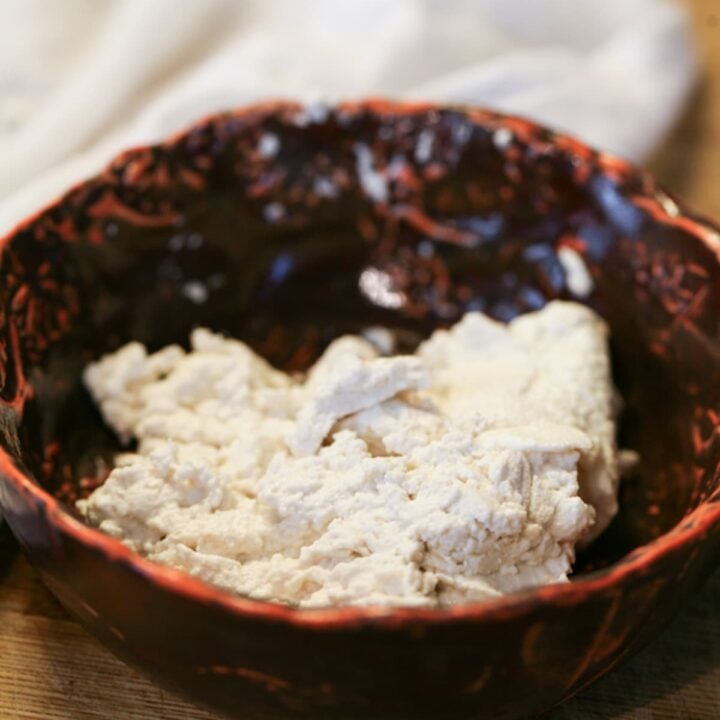
Ricotta From Whey
Delicious ricotta from whey. This ricotta is delicious and easy to make.
Ingredients
- A gallon of whey
- 1/4 cup vinegar (apple cider or distilled white)
- 1/2 teaspoon cheese salt or kosher salt
Instructions
- Heat the whey to 195 degrees Fahrenheit over medium heat. Stir constantly to prevent scorching.
- Remove from heat, add vinegar, stir and set aside for a few minutes.
- Line a colander with cheesecloth, add the whey. Let it drain a couple minutes.
- Collect the ends of the cloth, tie them, and hang to drain anywhere from one hour to a few hours depending on how much whey you are processing.
- Remove the ricotta from the cheesecloth and salt to taste with sea, cheese, or kosher salt.
** This ricotta can only be made from whey that was produced from making cheese without acids like vinegar, lemon juice, or citric acid. If you used vinegar to make your cheese, your cheese produced whey, and you are here trying to follow this recipe to make ricotta, this will not work.
Notes
Frequently Asked Questions...
- Can I keep my whey in the fridge?
Yes. If you make cheese and don’t have time to process the whey right away, feel free to keep it in the fridge for a day or two. Then take it out and heat it according to the recipe. - Can I freeze this ricotta cheese?
I’ve never tried but I think that it should freeze well. - Can I use the leftover whey?
You can use the whey leftover after making ricotta from whey to cook with or for baking if it’s not too vinegary for you. You can also add it to healthy smoothies or give it to your animals. - Can I use whey that was previously frozen?
I’ve never tried it but I think that it should work. - Can I use whey from store-bought milk?
Yes, as long as you used your store-bought milk to make cheese without using acids.
Nutrition Information:
Yield: 6 Serving Size: TablespoonAmount Per Serving: Calories: 60

Hi! I’m Lady Lee. I help homesteaders simplify their homesteading journey while still producing a ton of food! I am a single mother of four, I was born in Israel and raised in an agricultural commune called a Kibbutz. Now I homestead in central NC.


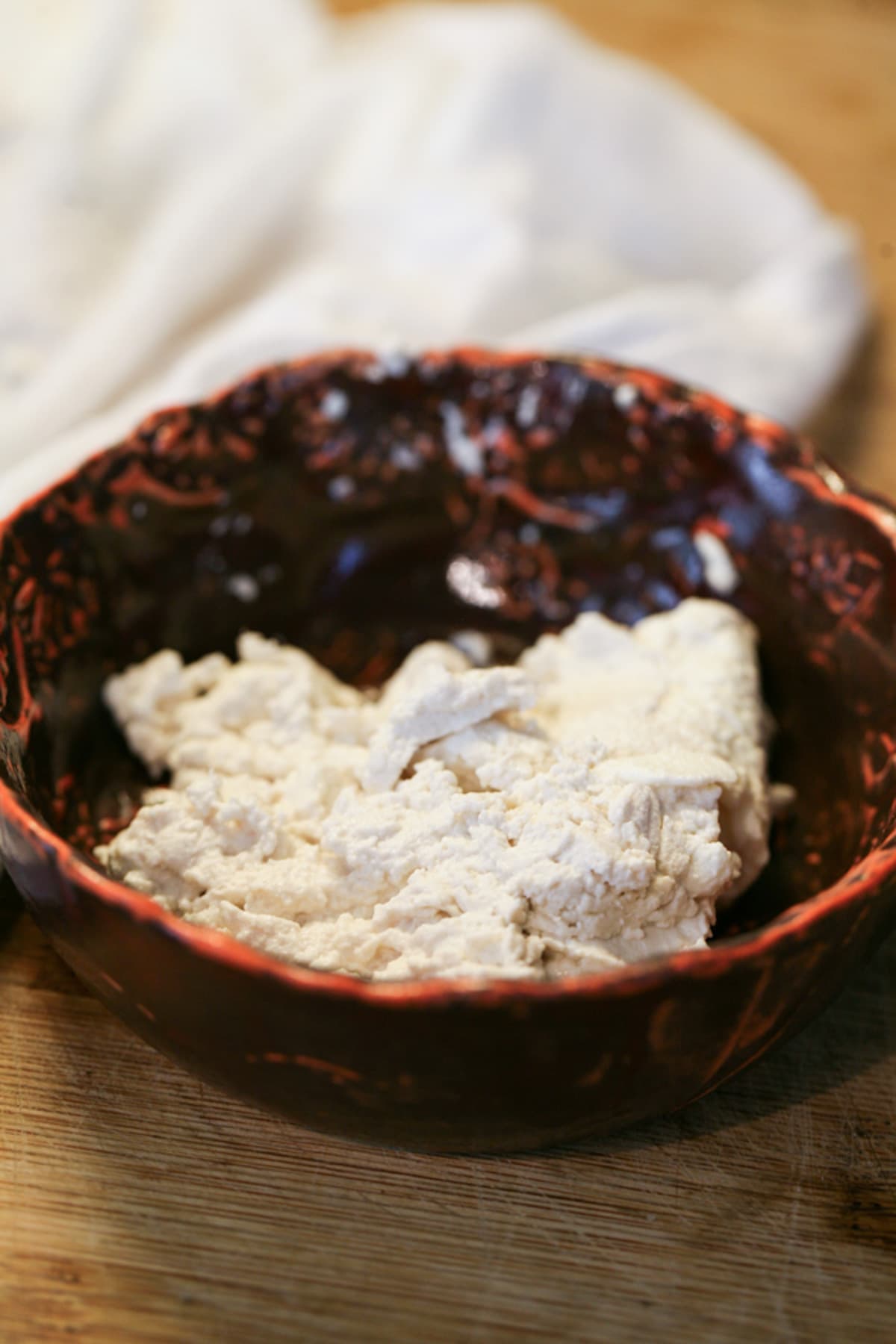
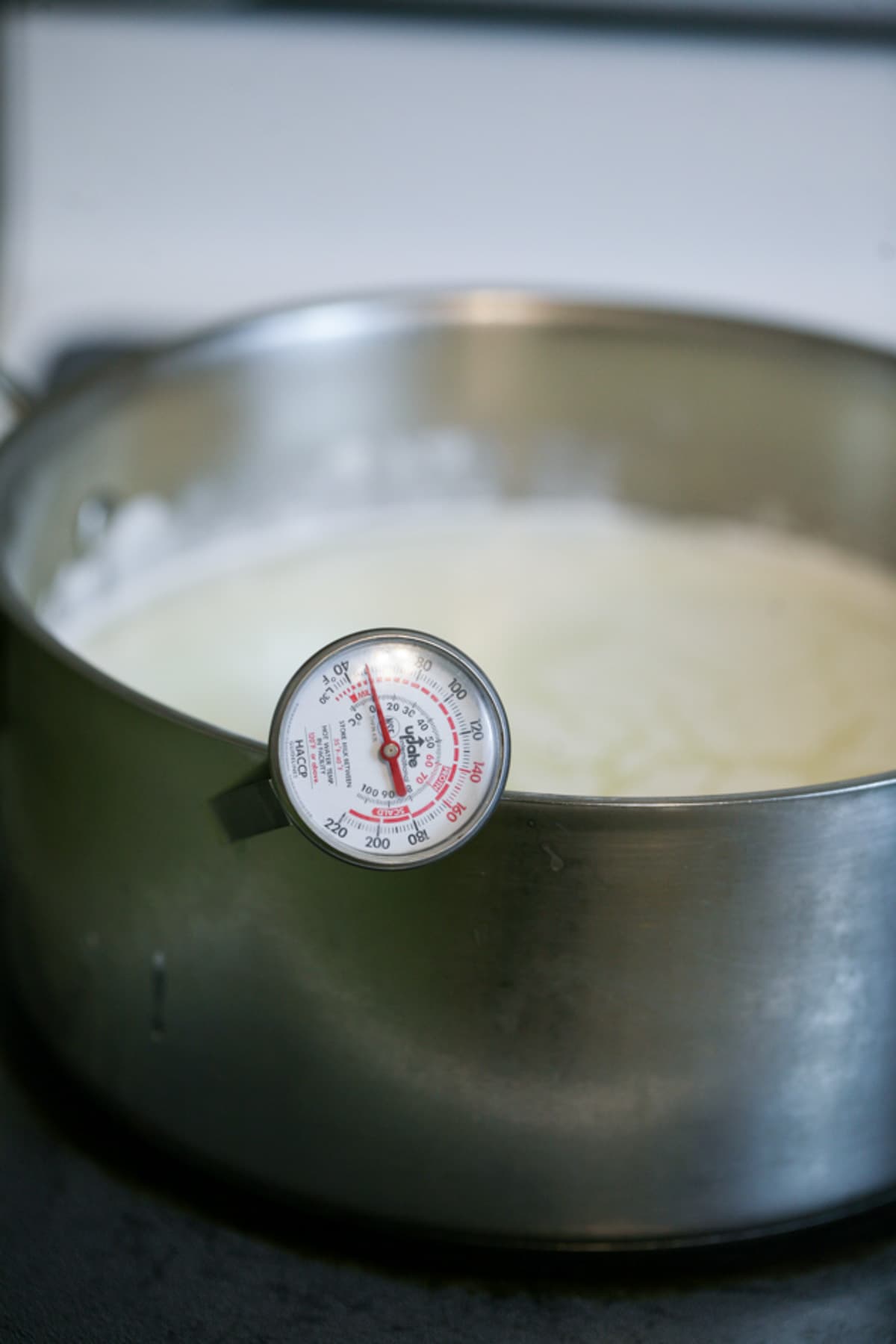
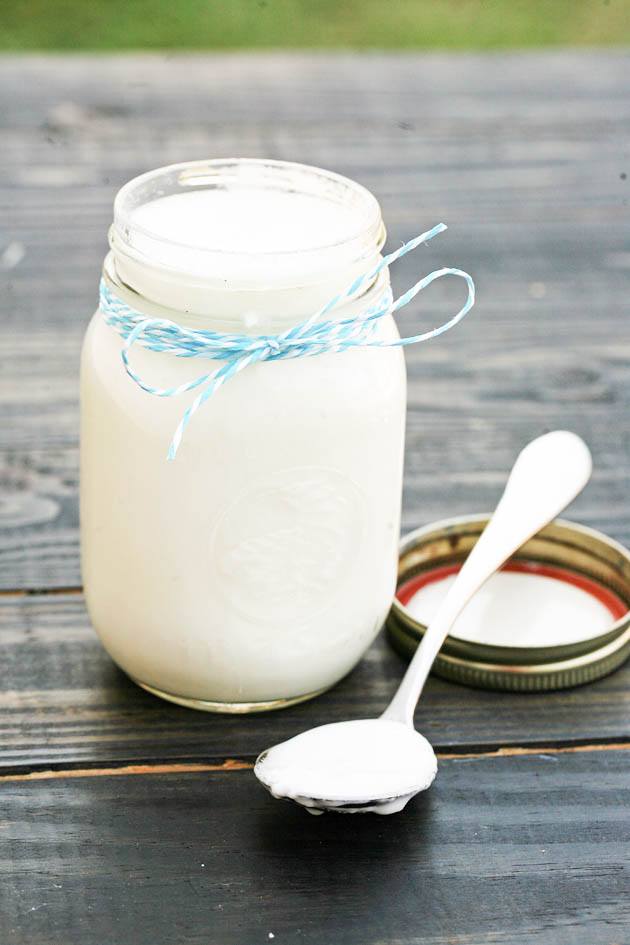
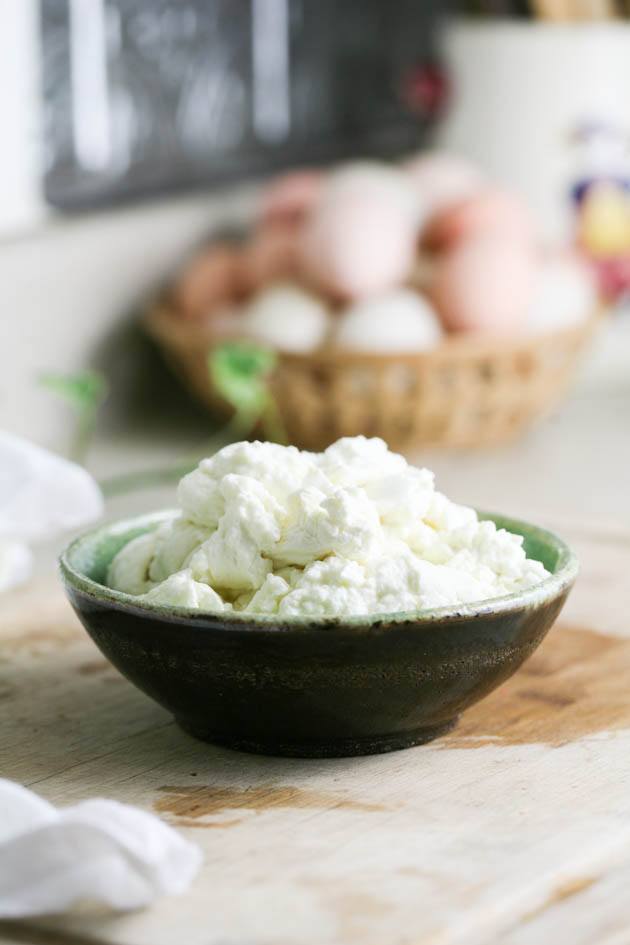
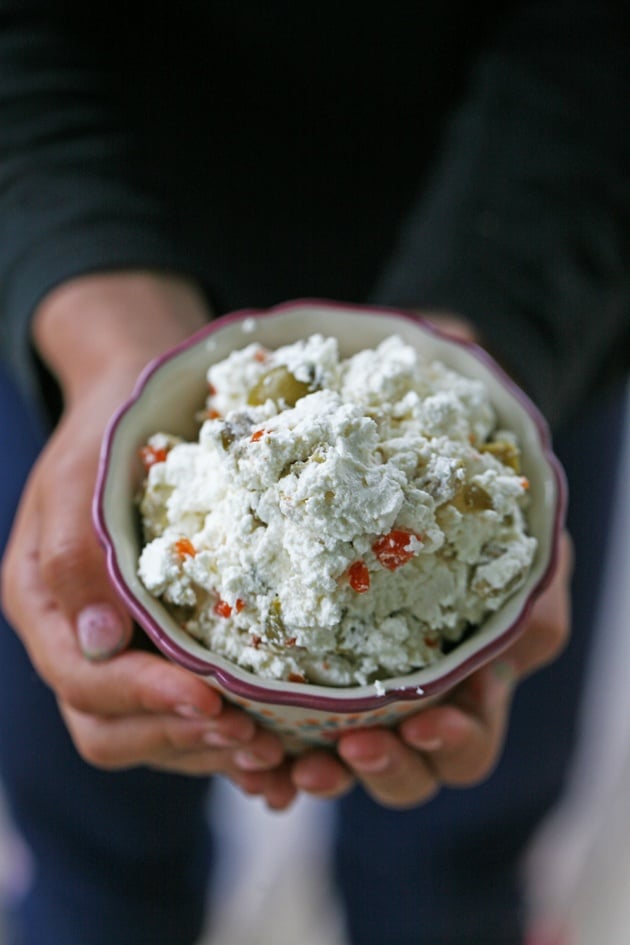
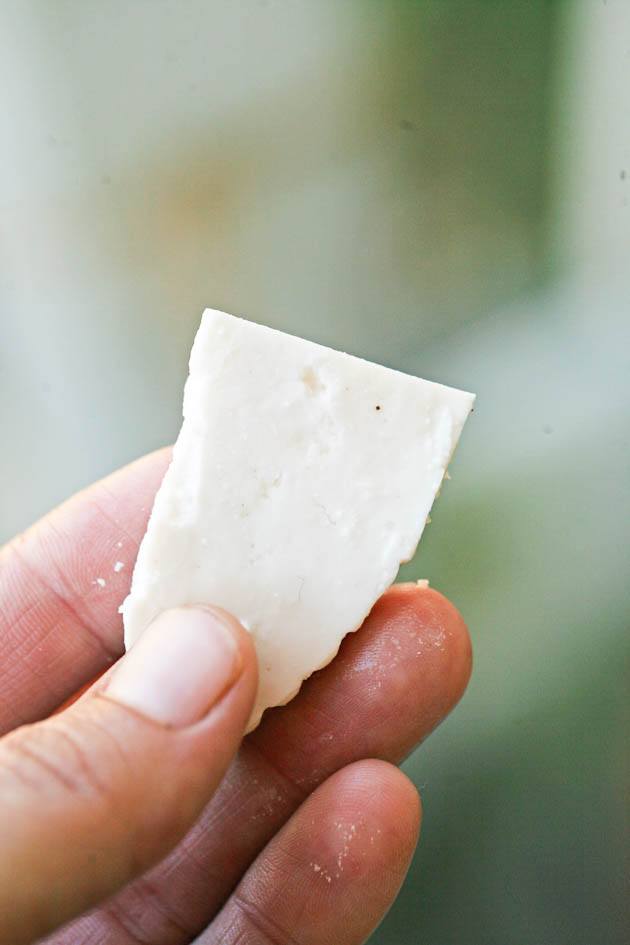
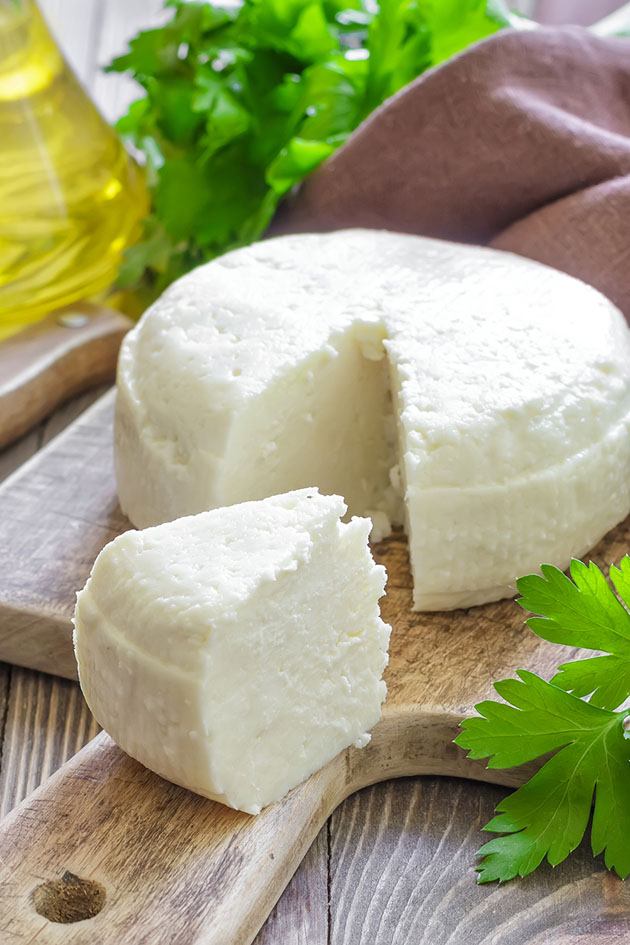
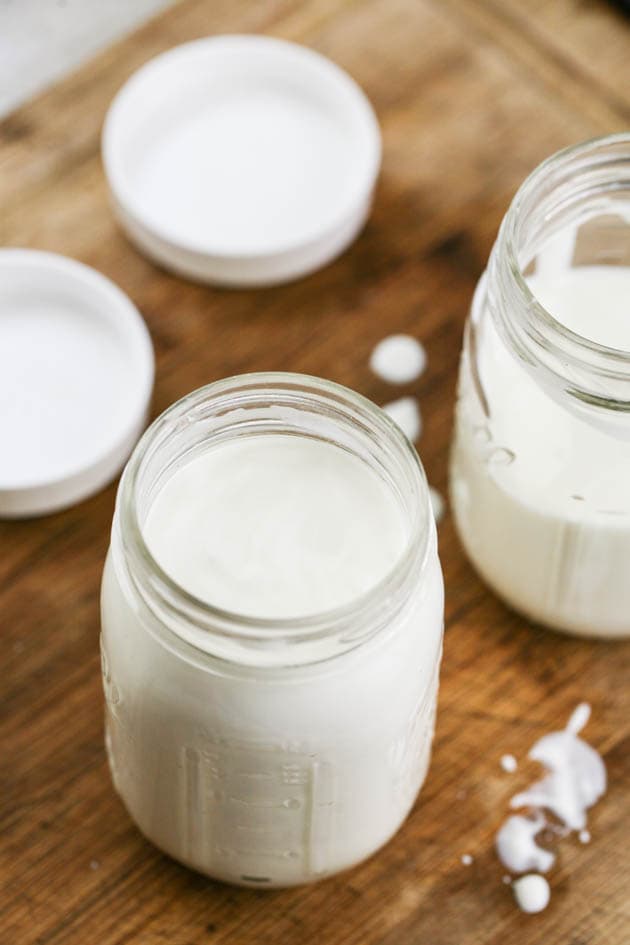
I stumbled across your recipe when researching how to use leftover whey. The recipe worked perfectly. I took the advice of another commenter and left the pot to sit for a while to really get the curds. Store bought ricotta is bland and tasteless but this homemade was amazing! I added Himalayan salt, black pepper, and fresh herbs from the garden. Thank for your sharing!!
Ohhh, I’m so happy it worked well. It didn’t work so well for others and I’m still trying to figure out why. I think that it’s the kind of cheese that you make before you use the whey. Still trying to work this one out. And you are right, I didn’t like and never ate or used ricotta before I learned how to make it. The stuff from the store is tasteless!
Hello, there! I usually don’t comment, but I have to tonight. I’ve made ricotta cheese for years, not just a gallon of whey, but ten, fifteen, or more! I love ricotta and also I hate waste.
I was curious as to how you made yours (besides, I read ALL your posts), and was very surprised to see that you used vinegar! I am from Central America, and I had NEVER heard about adding ANYTHING to the whey to make ricotta, just salt, and we BOIL the whey. Let it rest until it cools, then dip out the liquid until you can pour it in your cheese cloth to strain it. Delicious!
But the cheese we make is the regular “queso fresco” that you find in the Mexican stores.
But, if there is no acid (like vinegar), what is going to make the whey curdle? I’ve never tried to make it with just salt… I will have to try!
And, thanks for taking the time to comment!
So glad to hear I am not the only one loosing goats. I am in NC, also, on the coast. I an raisin LaMancha also. I lost one of my does shortly after she had twins. I am milking 1 doe now and am looking for good recipes to use my milk. Thank you for posting.
You are welcome. I have to mention that everything is so much better since I placed my chickens in the same fence with my goats! They seem to clean the ground real good.
I was reading through some of the comments on here and figured I’d post my findings. I made this yesterday. I had about 2 gallons of whey, some from yogurt, some from making mozzarella cheese. I used my fresh raw goats milk. I heated the whey, and when I added the vinegar, it looked like it was trying to coagulate. But when I tried to strain it, it looked like milk. So I poured it back into the pot, figuring it didn’t work. I ran some errands, and when I came back a while later, I definitely saw little curds. I figured I’d try to strain it once more. I let it hang for a while, and when I didn’t see any more whey dripping, I checked it and I had cheese! It was a really great tasting ricotta. I don’t know why it worked by letting it sit longer, but I just wanted to let you know I had success that way. Thank you!
Thanks for this! It might very well be that it needs a bit of extra time to work. It’s on my never-ending list of things to do – to retest this- but still didn’t get to it.
Hi I make yogurt and yesterday made my first ricotta but I used whole milk. I had no clue I could use whey from my yogurt. Am I understanding this correctly ? I can just use the whey from my yogurt. That seems incredible.
Usually, when I make yogurt I don’t have too much whey left over. I’m not sure that it will work but give it a try. It’s simple enough to try it once after you make yogurt. Report back if you can! I’m curious.
Can I use whey that has been frozen to make ricotta or other cheeses?
I’ve never tried it. Some people report that this works and some didn’t have success. I think that it has to do with the sort of cheese you made to produce the what and the ingredients in it, however, I didn’t pin everything down yet… So I guess the only way to know will be to give it a try.
It didn’t work! I’m using goat milk
What kind of cheese did you make before you tried to use the whey to make ricotta? It seems to work after certain types of cheeses but not after others and I’m trying to pin down exactly when it does work and when it doesn’t…
Have you tried making it from yogurt whey?
No. I usually make it after I make feta or soft goat cheese. If it works, let me know!
Can you make ricotta if the cheese you make used vinegar to develop the curd. Is their enough milk solids left to reheat, add additional vinegar and make ricotta?
Mmmm… I am really not sure. I’ve never tried. Most of the cheeses that I make don’t use vinegar as the coagulant… The only way to know is to give it a try.
I just tried it and doesn’t work. No more milk solids left to coagulate…now my whey has wheeeeeyyyy too much vinegar in it lol. Oh well
Can I ask what kind of cheese did you make with the milk?
No, the whey has to be from rennet made cheese. If you use vinegar to make the cheese, you’ve already got all the solids that way.
The microwave is handy for making this. Since it heats evenly, you don’t have to worry about scalding. The first time you have to cook in small increments so that you don’t overshoot the temp. But, eventually you figure out the right time for your microwave. You then just mix, heat and drain.
Ok, what am I missing. You mention milk but there is no milk in the ingredients list for the recipe.
When, where and how much milk is added?I’m obviously a novice :/
You use milk to make whatever cheese you want, let’s say feta for example. When you hang your feta to drain you get whey. This ricotta cheese is made from the whey that is left over after you make cheese from milk. I hope this makes sense… It’s a way to produce one more kind of cheese from the whey before you get rid of it (or use it to make bread or whatever).
So you don’t use milk to make this ricotta but you use the whey that is left over after you made cheese from milk.
I tried this today using whey produced when I make Greek yogurt. I used store bought whole milk and Half and half (equal amounts) to make yogurt. The whey is a cloudy yellow initially. Then I followed the exact instructions and nothing happened at all. No curds, no nothing the whey went right through just as it was. So there has to be something different? Maybe not enough casein left after making yogurt? I really want something to do with this whey
Yeah… From other people that tried it and commented, it seems like it doesn’t work with whey produced in any cheesemaking process. Only in certain cheeses but I didn’t have the chance to check every type of whey yet.
There are a lot of things that you can do with the whey. If you make bread you can replace the water with whey. I usually give it to my dog since it’s very healthy. There are many ideas online.
I have been successful making greek yogurt from store bought milk. I typically use 2L (1/2 gal) and tried 1% milk to 3.25% regular or lactose free milk. I mention all these varieties of milk because of the resulting whey. The 1% milk produced a clear colored whey with a faint deposit of what I think is milk solids along the bottom of the 2 cup container. The 3,25% milk produces a transparent, much brighter yellow colored whey with about 1/3 milk deposit on the bottom of the 2 cup container. My question, is it the deposit that eventually becomes ricotta? Can the remain whey be used and if so, in what?
I think that it is the remaining milk that becomes the ricotta. You can definitely use the remaining whey after making the ricotta. I mostly use it to make bread instead of using water. But there are many other ways to use it. Basically, it can replace water in any recipe.
Tried this out today… it didn’t work at all! I heated the whey — fresh from this morning — to 195 on medium heat, stirred constantly. Then took off heat, added the white vinegar, stirred. Nothin’. Left it for a while. Nothin’. Poured it thru cheesecloth-ed colander anyway, in case I wasn’t understanding something… and nothin’. Just liquid that drained right into the pot below. Need troubleshooting tips please!
Sounds like you did everything right… You should see the milk coagulates right when you add the vinegar, it shouldn’t take much time.
Check that your thermometer is reading the temperature right. Check that your vinegar is good and not too old. And I am curious as to what kind of whey did you use? From cow’s milk? Goat? What kind of cheese you made with the milk that produced the whey you used?
I am new at this but was wondering about a thought that crossed my mind. Would there be any difference in the results of the ricotta, or in C Smith’s case, a lack of, between using whole milk or pasteurized?
Also thank you for a wonderful, easy to follow tutorial. Am looking forward to trying this the next time I make mozzarella.
Am sure my daughter will thank you for this as well, she cant get enough cheese!
I’ve tried to ask around and find more information but no one seems to have the answer… The only thing to do is just try different kinds of milk. maybe from different animals or whole milk and then pasteurized… I’ll keep trying to find the reason, meanwhile, I hope it will work for you! Let me know. It’s a really tasty cheese.
I didn’t get a thing either. I refrigerated the whey since it was late, boiled it the next morning, added vinegar and got 1/4 tsp? Nothing happened! I used store whole milk to make yogurt.
So, first, you made yogurt and after you made yogurt you used the whey to make ricotta? Did you have enough whey? I never have a lot of whey when making yogurt… How do you make yogurt? Or maybe I didn’t understand this right…
Good day, I just recently began making Greek yogurt and now feta cheese. Now I can use the whey for riccota cheese and not just for smoothies. I’m looking forward to making my first batch of riccota cheese. Thank you for posting this blog! Mr. Royce Faina
You are welcome! It’s agreat cheese, you’ll love it.
Is one cup of Ricotta from 1 gallon on goat whey a normal amount for you? After making Chevre or strained yogurt I can’t ever seem to get more than an amount the size of a walnut out of the whey.
Yes, It’s what I usually get, more or less. I am trying to think of a reason that you don’t get as much but nothing comes to mind yet…
Could it be the type of cheese or yogurt being made that makes a difference?
I didn’t think that it will be a factor that’s why I didn’t say anything about it in the post, but I guess that the only way to know will be to try to use whey from different kinds of cheese. I am going to try next time that I make yogurt. We’ll see.
I, too, absolutely loved the homemade ricotta. It seemed so much more flavorful and sweet than the store-bought one!!
I agree! The one from the store has no flavor at all. I use it only in baking and such where the flavor comes from something else. But this homemade one I can eat just spread on a toast. It’s so good!
This was an absolutely amazing teaching article! Thank you so much—the pictures, the commentary, the recipe—so Professional and yet so engaging. I just got my first dairy a2a2 mini-moo and I’m so excited to do these things. Blessings to you and yours.
Thank you, Ann! I am glad you liked it. It became one of my favorite cheeses to make.
That looks wonderful. Glad you discovered another way to double use something-up. You mentioned making a lasagna, it’s a bit more work but do try making a Manicotti. It’s ricotta’s crowing glory!
Never even heard about Manicotti! I’ll have to look it up.